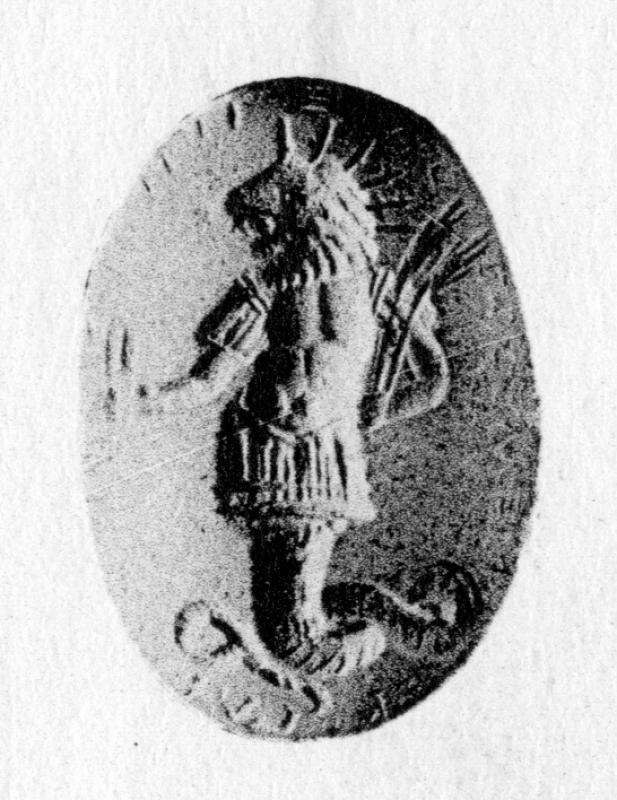Bonner, SMA, 55.
heart.18 But the third decan of Cancer has a similar name, Chnouphos, though the form here is entirely different — a bust resting on a base, and with two female faces turned in opposite directions. In Hephaestion of Thebes, Chnoumis is the third decan of Cancer and is expressly said to be used as a φυλακτήριον τοῦ στομάχου;19 Χαρχνουμις is first decan of Leo, but nothing is said of his appearance or special powers.20 The name may be represented by Χολχνουβις and Χραχνουβις,21 names attested on a few amulets that belong to this general class. In the περὶ λίθων of Socrates and Dionysius we have the prescription:
ἐπιχάρασσε οὖν εἰς αὐτον (i.e. λίθος ὀνυχίτης) σπείραμα ὄφεως ἔχον προτομὴν ἤτοι κεφαλὴν λέοντος καὶ ἀκτῖνας. οὗτος φορούμενος οὐκ ἐᾷ ὅλως ἀλῆσαι τὸν στόμαχον, ἀλλὰ καὶ ὅσαις ἂν χρήσῃ τροφαῖς εὐπεπτήσεις.22
“Engrave on it (a kind of onyx) a serpent coil with the upper part or head of a lion, with rays. Worn thus it prevents pain in the stomach; you will easily digest every kind of food.”
It may be safely assumed, then, that stones in which the principal design is the lion-headed snake are stomach amulets; and we may accept as the typical design a thick-bodied serpent with the head of a lion, usually facing to the left of the stone. The coils of the snake are often elaborately rendered, with a loop on each side of the upreared head and neck; but variations are common, and in a few examples the snake is almost straight. There are usually seven or twelve rays round the head, sometimes six; sometimes there are twelve arranged in six pairs, and occasionally there are seven pairs. When the rays are arranged in pairs there is a nimbus encircling the head; the rays may then begin at the circumference of the nimbus or at the head and project beyond the nimbus. When there are seven rays, the seven vowels are sometimes placed at the ends of the rays or between them; sometimes the letters of the name Χνοῦβις are similarly placed. In several specimens the serpent is on or just above a little altar or base.
A much more striking variety of the lion-headed Chnoubis is, as far as I know, represented by four stones, three of which are in Ann Arbor. Two of them are so similar in design and execution that they may well have come from the same workshop. The first, which belongs to the collection of President A. G. Ruthven, is a gray-green oval steatite, convex on the obverse, flat on the reverse, with a very narrow bevel (D. 99). On the obverse is a lion-headed demon facing left; he has the trunk and arms of a man, and wears a cuirass fitted to the lines of his body; under this is a tunic with short sleeves, which forms a kilt below the cuirass. The lower half of the body is a serpent with a large coil on each side of the upright part. There are six rays round
18 C. E. Ruelle, “Hermès Trismégiste, le livre sacré sur les decans,” Rev. de Philol., 32 (1908), 260.
19 Pp. 52, 26; 53, 22–24 (ed. Engelbrecht).
20 P. 54, 15.
21 Χραχνουβις is inscribed in the field of a Chnoubis amulet in Raspe, No. 556. References to stones inscribed Χολχνουßιs will be given below.
22 Mély-Ruelle, II, 177.
Last modified: 2012-11-05 10:37:47
Link: cbd.mfab.hu/pandecta/1494
